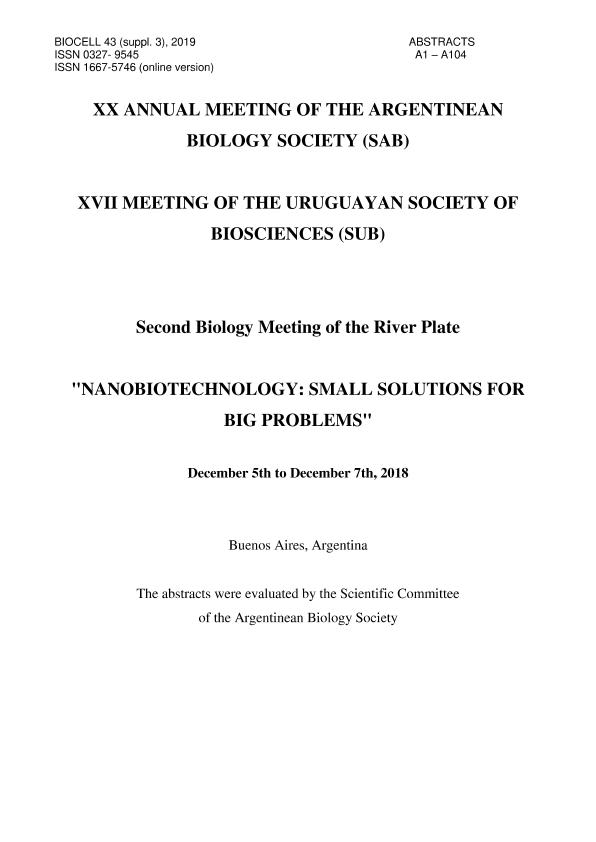Evento
Effect of glucose concentration on growth and fatty acids profile of two Rhodotorula glutinis strains
Angelicola, María Virginia ; Viñarta, Silvana Carolina
; Viñarta, Silvana Carolina ; Aybar, Manuel Javier
; Aybar, Manuel Javier ; Castellanos, Lucia Ines
; Castellanos, Lucia Ines
 ; Viñarta, Silvana Carolina
; Viñarta, Silvana Carolina ; Aybar, Manuel Javier
; Aybar, Manuel Javier ; Castellanos, Lucia Ines
; Castellanos, Lucia Ines
Tipo del evento:
Jornada
Nombre del evento:
XX Jornadas Anuales de la Sociedad Argentina de Biología y XVII Jornadas de la Sociedad Uruguaya de Biociencias
Fecha del evento:
05/12/2018
Institución Organizadora:
Sociedad Uruguaya de Biociencias;
Sociedad Argentina de Biología;
Título de la revista:
Biocell
Editorial:
Sociedad Argentina de Biología
Idioma:
Inglés
Clasificación temática:
Resumen
Certain oleaginous yeasts as Rhodotorula glutinis can accumulate neutral lipids up to 70% of dry biomass, consisting mainly in triacylglycerols (TAG), under appropriate culture conditions. Microbial TAG represent a valuable alternative feedstock for biodiesel production. Lipid accumulation occurs under nutrient limitations, mainly nitrogen, with simultaneous excess of carbon source. The lipid synthesis and fatty acids (FA) composition are influenced by several factors as carbon source (type and concentration), aeration, growth, temperature, C/N ratio, pH, among others parameters.. Effect of initial glucose concentration (30, 40 and 100 g L-1) on growth, lipid synthesis and FA profile of two strains of R. glutinis (R4 and R48) isolated from Antarctica was investigated using a nitrogen-limited medium (MI). Yeasts were incubated aerobically on a rotatory shaker during 120 h at 250 rpm and 25 °C. Analytical determinations (biomass, lipid production, lipid content and residual glucose) were performed after 120 h of culture time. Glucose affected the growth of the strains and the FA profile of the microbial TAG. According to the results, the growth exhibited by R48 (12.33-13.83 g L-1) were higher than R4 (8.42-10.83 g L-1) for all glucose concentrations assayed. An increase of the lipid content (from 50.6 to 60.2%) and a decrease of the biomass were exhibited by R4 when the glucose concentration increased from 30 to 100 g L-1. However, significant differences on lipid accumulation and growth were not observed for R48. The FA profile of microbial lipids was analyzed by GC-FID (Viñarta et al. 2016). FA with chain length between 14 and 18 carbons dominated the lipidic profile of both strains. Eighteen-carbons FA were the most abundant (68.27-85.59%). The increase of glucose concentration affected the FA composition of the yeasts. Higher glucose concentrations caused an increase in the relative abundance of oleic and palmitic acids with a simultaneous decrease of linoleic and linolenic acids in in the FA content of R48 strain. Different effect of glucose concentration was observed in R4 and a decrease of oleic and linoleic acids with an increase of palmitic acid were observed at the highest glucose concentration. Results demonstrate that the FA profile of R. glutinis R4 and R. glutinis R48 are comparable with other oleaginous yeasts reported in the literature. The better FA composition as feedstock for biodiesel was observed by R4 with 30 g L-1 of glucose, whilst for R48, with 100 g L-1. The FA profile of R. glutinis R4, with a high content of oleic acid (~60%), is quite similar to vegetables oils, indicating that its lipids have potential as a feedstock for biodiesel production.
Palabras clave:
OLEAGINOUS YEASTS
,
COLD ADAPTED YEASTS
,
BIODIESEL
,
SINGLE CELL OILS
Archivos asociados
Licencia
Identificadores
Colecciones
Eventos(PROIMI)
Eventos de PLANTA PILOTO DE PROC.IND.MICROBIOLOGICOS (I)
Eventos de PLANTA PILOTO DE PROC.IND.MICROBIOLOGICOS (I)
Citación
Effect of glucose concentration on growth and fatty acids profile of two Rhodotorula glutinis strains; XX Jornadas Anuales de la Sociedad Argentina de Biología y XVII Jornadas de la Sociedad Uruguaya de Biociencias; Ciudad Autónoma de Buenos Aires; Argentina; 2018; 1-2
Compartir



